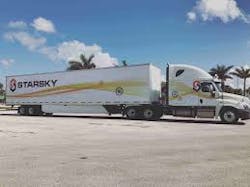Starsky Robotics announced it has started testing unmanned trucks on public highways with live traffic in Florida.
The first unmanned test in live traffic took place on June 16, with the heavy-duty truck traveling 9.4 miles on the Florida Turnpike. It successfully navigated a rest area, merged onto the highway, changed lanes and maintained a speed of 55 mph.
The start-up company’s goal is to solve the driver shortage by making trucks automated on the highway and remote controlled by human drivers for the first and last miles. In this case, an operator was located in an office in Jacksonville, about 200 miles away from the truck.
“We aren’t building fully autonomous trucks designed to operate without any human intervention or relying exclusively on computers to make every driving decision,” said Stefan Seltz-Axmacher, CEO and co-founder of Starsky Robotics. “We know that today, humans are better at navigating many of the nuances of driving than even the most advanced computer systems, which is why we use remote drivers to help our trucks at their most contextually complex junctures.”
Earlier this month, Florida Gov. Ron DeSantis signed a bill that allows self-driving vehicles to run without a human operator, effective July 1. The vehicle must meet insurance and safety requirements.
Back in February 2018, Starsky became the first company to remove the driver during an unmanned trip on a closed seven-mile stretch of road in Florida, traveling at 25 mph. Since then it also record for the fastest unmanned road-legal vehicle, when one of its trucks hit 55 mph during a test on a closed portion of the Selmon Expressway outside Tampa.
As the company continues to invest in automated trucking, it is also running a more traditional trucking operation to bring in revenue. It currently has a fleet of 36 trucks. It has been actively recruiting truck drivers with at least nine months of over-the-road experience, and hopes to transition some of them to the automated trucking operations in the future.
“Driving trucks is extremely tough and so is finding the right drivers to be a part of this unique opportunity. We use our growing regular trucking business as a captive source of safe, experienced, and well-trained drivers to staff our safety and remote driver team,” said Seltz-Axmacher.




